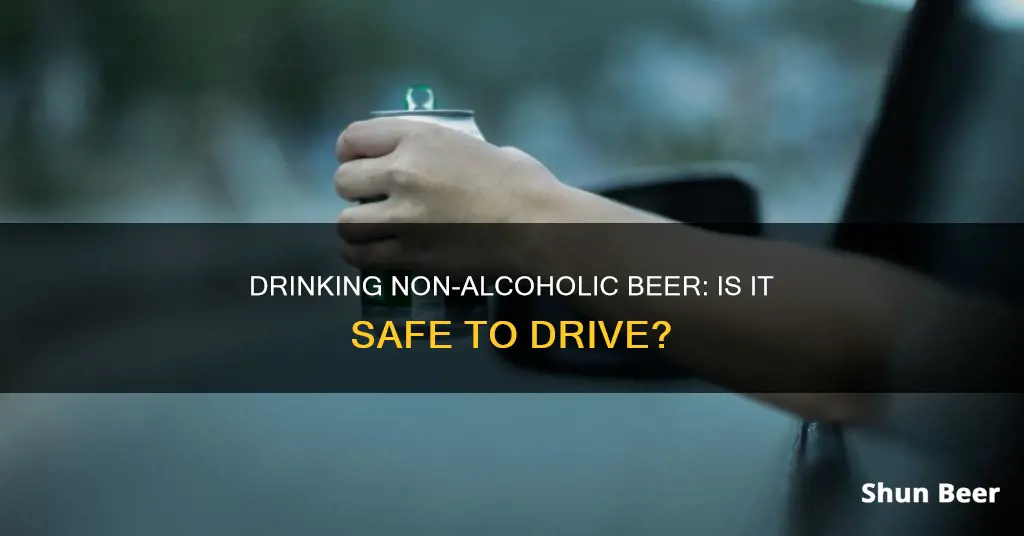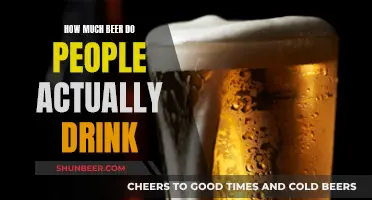
Drinking and driving is dangerous and illegal. Alcohol slows down your reactions and impairs your judgement, making it unsafe for you to drive and putting yourself and others at risk of accidents. The best advice is to avoid alcohol completely if you plan on driving. If you do drink, there may still be enough alcohol in your system the next morning for you to be over the limit and unsafe to drive. In the UK, the drink-drive alcohol limit varies depending on the region. In England, Wales and Northern Ireland, the limit is 80mg of alcohol per 100ml of blood, 107mg of alcohol per 100ml of urine, or 35 micrograms of alcohol per 100ml of breath. In Scotland, the limit is lower: 50mg of alcohol per 100ml of blood, 67mg of alcohol per 100ml of urine, or 22 micrograms of alcohol per 100ml of breath. While non-alcoholic or low-alcohol beverages are generally considered safe, it is important to note that even small amounts of alcohol can affect your ability to drive.
What You'll Learn

Is non-alcoholic beer safe to drink and drive?
The safest advice is to avoid alcohol completely if you have to drive. Even small amounts of alcohol can affect your ability to drive, and there is no reliable way to drink and stay within the limit. Alcohol affects everyone differently, and there are many factors that determine how your body absorbs alcohol. These include your sex, weight, what you've eaten, your age, and your stress levels.
The UK's drink-drive limit varies across the country. In England, Wales, and Northern Ireland, the drink-driving alcohol limit for drivers is:
- 80mg of alcohol per 100ml of blood
- 107mg of alcohol per 100ml of urine
- 35 micrograms of alcohol per 100ml of breath
Scotland has stricter limits:
- 50mg of alcohol per 100ml of blood
- 67mg of alcohol per 100ml of urine
- 22 micrograms of alcohol per 100ml of breath
Non-alcoholic beer typically contains 0.05% alcohol or less. While this is a very small amount, it is not always true that non-alcoholic beer is completely alcohol-free. Since the alcohol content is so low, it is unlikely that drinking non-alcoholic beer will put you over the drink-drive limit. However, it is important to remember that alcohol affects everyone differently, and there is no precise way to determine how much alcohol you can consume before driving.
If you are the designated driver, it is best to avoid drinking any alcohol. Instead, opt for non-alcoholic drinks, which are a safe alternative and have never been more popular.
Beer on the Chicago Metra: What's the Rule?
You may want to see also

What is the UK drink-drive limit?
In the UK, the general advice is to avoid alcohol completely if you have to drive. Even small amounts of alcohol can affect your ability to drive, and there is no reliable way to drink and stay within the limit. The police advise that you should avoid alcohol altogether if you plan to drive.
The UK drink-drive limit varies depending on the region. In England, Wales, and Northern Ireland, the drink-driving alcohol limit for drivers is:
- 80 milligrammes of alcohol per 100 millilitres of blood (the 'blood limit')
- 35 micrograms per 100 millilitres of breath (the 'breath limit')
- 107 milligrammes per 100 millilitres of urine (the 'urine limit')
In Scotland, the drink-drive alcohol limit is lower:
- 50 milligrammes of alcohol per 100 millilitres of blood (the 'blood limit')
- 22 microgrammes of alcohol per 100 millilitres of breath (the 'breath limit')
- 67 milligrammes per 100 millilitres of urine (the 'urine limit')
It is worth noting that these limits are a general guide, and the rate at which your body absorbs alcohol depends on various factors, including your sex, weight, metabolism, age, what you've eaten, and your stress levels. Therefore, it is challenging to determine precisely how many drinks will put you over the limit. The safest option is to refrain from drinking if you plan to drive.
Beer and Brilinta: What You Need to Know
You may want to see also

How does alcohol affect driving?
Drinking alcohol and driving is extremely dangerous and puts you and others at risk of accidents. Alcohol is a depressant drug that slows down the activity of the central nervous system, including the brain. This can have a significant impact on your ability to drive safely.
- Altered judgment and risk-taking behaviour: Alcohol can impair your ability to think clearly, make good decisions, and plan ahead. It can also increase your propensity for risk-taking, which is dangerous when operating a vehicle.
- Reduced ability to concentrate: Driving requires a lot of concentration, and alcohol impairs your ability to focus on the numerous tasks involved in driving, such as steering, maintaining speed, staying in your lane, and avoiding other vehicles.
- Loss of coordination: Alcohol affects the parts of the brain that control motor skills, slowing down reflexes and decreasing your ability to steer or use the gas and brake pedals effectively.
- Impaired vision: Alcohol relaxes the eye muscles, causing blurred vision and slower visual reaction times. It also reduces peripheral vision, making it difficult for drunk drivers to see anything that isn't directly in front of them, including pedestrians, other vehicles, and obstacles on the road.
- Delayed messages to the brain: Alcohol slows down the rate at which the brain receives messages from the eyes, affecting your ability to process information and react appropriately.
- Increased likelihood of falling asleep: Alcohol can cause relaxation and drowsiness, which may lead to falling asleep at the wheel.
- Reduced reaction times: Studies have shown that higher blood alcohol concentration (BAC) is associated with decreased reaction times. Even a small increase in BAC can result in a noticeable delay in reaction time, making it harder to respond to unexpected situations while driving.
It is important to note that these effects can vary from person to person and are influenced by factors such as weight, age, sex, metabolism, stress levels, and the amount and type of alcohol consumed. Therefore, it is always best to avoid alcohol entirely if you plan to drive. If you need to drive, consider having non-alcoholic drinks or arranging alternative transportation, such as a designated driver or public transport.
Beer and Yeast Infections: Is It Safe to Drink?
You may want to see also

What are the penalties for drink-driving?
While non-alcoholic beers typically contain less than 0.5% alcohol by volume (ABV), it is still possible to be charged with a drink-driving offence if you have consumed enough of it to exceed the legal limit. The safest option is to avoid alcohol altogether if you plan to drive.
Drink-driving penalties vary depending on the jurisdiction, the driver's experience, and the severity of the offence. Here are some general penalties for drink-driving:
- UK: In England, Wales, and Northern Ireland, the drink-drive alcohol limit is 80mg of alcohol per 100ml of blood, 107mg per 100ml of urine, or 35 micrograms per 100ml of breath. In Scotland, the limits are lower: 50mg per 100ml of blood, 67mg per 100ml of urine, or 22 micrograms per 100ml of breath. Being found guilty of drink-driving can result in a driving ban of at least a year, up to six months in prison, and an unlimited fine. Causing death by careless driving while under the influence can lead to a 14-year prison sentence, an unlimited fine, a minimum two-year driving ban, and an extended driving test.
- Ireland: The drink-drive limit in Ireland is 50mg of alcohol per 100ml of blood, 67mg per 100ml of urine, or 22 micrograms per 100ml of breath for experienced drivers. For learner, novice, and professional drivers, the limits are lower: 20mg per 100ml of blood, 27mg per 100ml of urine, or 9 micrograms per 100ml of breath. The penalties for drink-driving in Ireland include a fine of €200 and a three-month driving ban for a first offence. For higher levels of alcohol, the fine increases to €400, and the ban to six months. Repeat offences result in longer bans, and for the highest levels of alcohol, the maximum penalty is a €5,000 fine or six months in prison, or both.
Beer and Medrol: Safe Mix or Health Risk?
You may want to see also

How long after drinking is it safe to drive?
Drinking and driving is a dangerous combination and can impair your driving ability in several ways. Alcohol slows your reaction time, inhibits your ability to focus on driving, affects your ability to control the car or speed, reduces coordination, and makes it difficult to track moving objects.
The safest option is to avoid alcohol altogether if you plan to drive. If you need to drive, it is best to have a designated driver or use public transportation. There is no foolproof way to determine how long you should wait to drive after drinking, as it depends on various factors, including the amount and type of alcohol consumed, age, sex, weight, food intake, stress levels, and other substances or medications taken.
As a general rule of thumb, it is recommended to wait at least one hour per drink. However, this is not a sure-fire way to keep your blood alcohol concentration (BAC) down, as other factors can influence it. For example, drinking on an empty stomach will result in faster absorption and a higher concentration of alcohol in your system. Additionally, your weight affects how quickly your body metabolizes alcohol; the less you weigh, the faster the absorption and the higher the concentration of alcohol in your bloodstream.
It is important to remember that even if you feel fine after drinking, your driving skills can still be impaired, and you may be over the legal limit. The only way to ensure your blood alcohol level is below the legal limit is to abstain from drinking before driving. The effects of alcohol can last longer than you might expect, and you could still be over the limit the next morning.
In conclusion, there is no definitive answer to how long you should wait to drive after drinking. The safest option is to avoid drinking altogether if you need to drive or plan alternative transportation.
Beer Olympics: Competitive Drinking Games Explained
You may want to see also
Frequently asked questions
It is not illegal to drink non-alcoholic beer while driving, but it could carry the same careless driving penalty if you’re accused of being distracted. The safest and best advice is to avoid alcohol completely if you have to drive.
In England, Wales, and Northern Ireland, the drink-drive alcohol limit for drivers is 80mg of alcohol per 100ml of blood, 107mg of alcohol per 100ml of urine, or 35 micrograms of alcohol per 100ml of breath. In Scotland, the limits are lower: 50mg of alcohol per 100ml of blood, 67mg of alcohol per 100ml of urine, or 22 micrograms of alcohol per 100ml of breath.
Drinking alcohol slows down your reactions and impairs judgment, making your driving unsafe and putting you and others at greater risk of accidents. Many of the functions that we depend on to drive safely are affected when we drink alcohol, including slower reaction times, impaired vision, and reduced ability to concentrate.
Being found guilty of driving while above the legal drink-driving alcohol limit can result in a driving ban of at least one year, up to six months in prison, and an unlimited fine. Causing death by careless driving while under the influence of alcohol can result in up to 14 years in prison, an unlimited fine, a minimum two-year driving ban, and an extended driving test.







